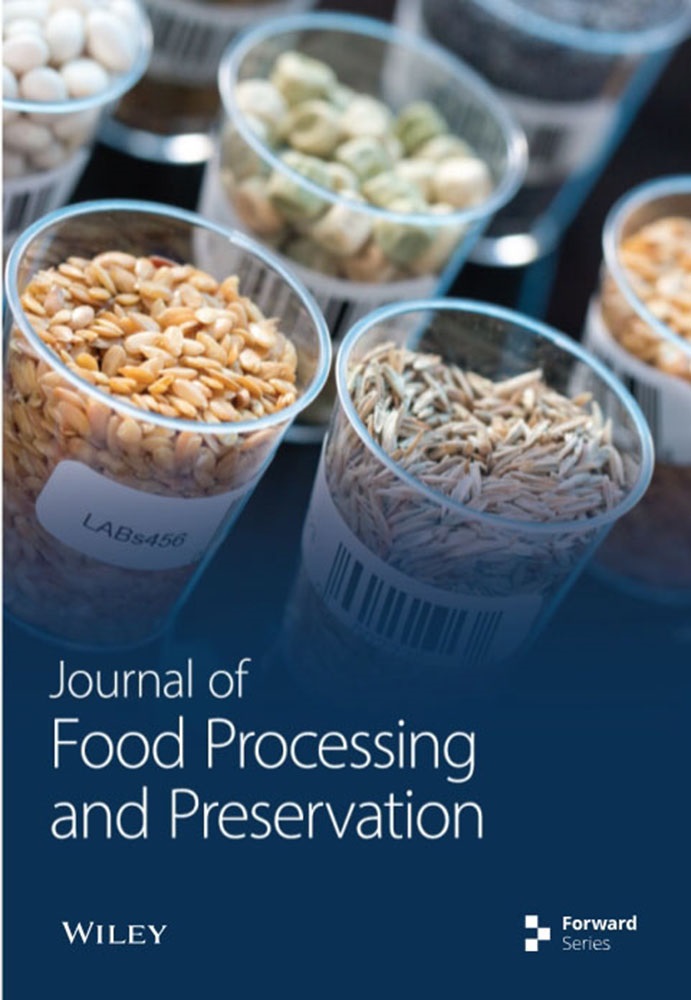Characterization of Cocoa Butter Replacer Developed from Agricultural Waste of Mango Kernel and Rice Bran
IF 2
3区 农林科学
Q3 FOOD SCIENCE & TECHNOLOGY
引用次数: 0
Abstract
The unique physicochemical properties of cocoa butter (CB) provide the desired physical properties in chocolate. Due to its high demand, increasing price, and limited supply, people are looking for cocoa butter alternatives (CBAs). In this study, CBA was prepared using enzymatic acidolysis on mango kernel fat stearin with rice bran oil blend. Reaction parameters (time (4-8 h), temperature (50-70°C), and enzyme load (6-10%, w/w)) were optimized using response surface methodology to produce similar triacylglycerol (TAG) composition as CB, and the properties of different proportions of CBAs with CB were assessed. Triacylglycerol content, melting behavior, solid fat content, crystal morphology, and polymorphism were investigated by high-performance liquid chromatography, differential scanning calorimetry, pulse nuclear magnetic resonance, polarized light microscopy, and X-ray diffraction, respectively. The optimum reaction condition to produce comparable percentages of monounsaturated TAGs in the final product was 8 h time, 8% enzyme load, and 50°C. After blending of CBA with CB in different proportions, no significant differences in terms of polymorphism, melting profile, and solid fat content were observed up to 20% CBA replacement. However, the TAG profile was similar up to 10% replacement of CB with CBA. In summary, the enzymatically produced CBA can potentially be used as a cocoa butter replacer up to 20% in the confectionery industry.利用芒果核和米糠等农业废弃物开发的可可脂替代物的特性分析
可可脂(CB)独特的物理化学特性为巧克力提供了所需的物理特性。由于可可脂需求量大、价格上涨、供应有限,人们正在寻找可可脂替代品(CBA)。本研究采用酶法酸解芒果核脂肪硬脂和米糠油混合物,制备了 CBA。采用响应面方法优化了反应参数(时间(4-8 小时)、温度(50-70°C)和酶载量(6-10%,w/w)),以产生与 CB 相似的三酰甘油(TAG)成分,并评估了不同比例的 CBA 与 CB 的特性。分别采用高效液相色谱法、差示扫描量热法、脉冲核磁共振法、偏光显微镜法和 X 射线衍射法对三酰甘油含量、熔化行为、固体脂肪含量、晶体形态和多态性进行了研究。要在最终产物中产生相当比例的单不饱和 TAG,最佳反应条件是 8 小时的反应时间、8% 的酶负荷和 50°C。将不同比例的 CBA 与 CB 混合后,在 CBA 替代率达到 20% 时,在多态性、熔融曲线和固体脂肪含量方面没有观察到显著差异。然而,在用 CBA 取代 10% 的 CB 之前,TAG 曲线是相似的。总之,在糖果业中,酶法生产的 CBA 可用作可可脂替代物,替代率可达 20%。
本文章由计算机程序翻译,如有差异,请以英文原文为准。
求助全文
约1分钟内获得全文
求助全文
来源期刊
CiteScore
5.30
自引率
12.00%
发文量
1000
审稿时长
2.3 months
期刊介绍:
The journal presents readers with the latest research, knowledge, emerging technologies, and advances in food processing and preservation. Encompassing chemical, physical, quality, and engineering properties of food materials, the Journal of Food Processing and Preservation provides a balance between fundamental chemistry and engineering principles and applicable food processing and preservation technologies.
This is the only journal dedicated to publishing both fundamental and applied research relating to food processing and preservation, benefiting the research, commercial, and industrial communities. It publishes research articles directed at the safe preservation and successful consumer acceptance of unique, innovative, non-traditional international or domestic foods. In addition, the journal features important discussions of current economic and regulatory policies and their effects on the safe and quality processing and preservation of a wide array of foods.

 求助内容:
求助内容: 应助结果提醒方式:
应助结果提醒方式:


